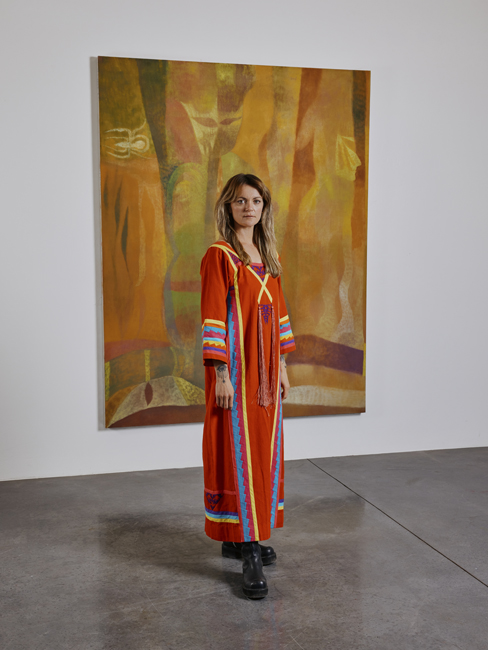December 16, 2022
Download as PDF
View on Southwest Contemporary

Maja Ruznic of Placitas, New Mexico. Photo: Brad Trone. Courtesy Maja Ruznic.
Maja Ruznic of Placitas, New Mexico builds and embraces darkness in canvas works that are informed by trauma and inspired by Carl Jung’s philosophy of the shadow self.
1.
Maja Ruznic opens the glass door to her studio space in Placitas, New Mexico.
I glimpse the spines of several books on a nearby shelf—Louise Bourgeois by Marie-Laure Bernadac, Woolgathering by Patti Smith, Shamanism by Mircea Eliade. The room has twenty-foot ceilings, stark white walls. Cold winter light filters in from a row of large square windows.
Maja and I stand near the center of the space, and a stack of three red panels draws my attention to the back wall. Maja’s arms stretch across the width of the canvases as she lifts and carries two to the side, so we can see the entire 300-by-seventy-six-inch triptych. The painting includes many strong colors, but my overall impression is red.
“I’m obsessed with red. Because my work is so intuitive and I don’t rely on sketches or photographs, I need something to anchor my practice. Lately, it’s a color.”
My eyes shift from Maja’s face to a figure within the canvas. A woman is pressing her fingertips against each another. The fingers of her left hand are barely more than a suggestion of three sharp pink lines, but the fingers on her right are full and gently curved.
“With these, I’m interested in what I can do with red… if I can make a calm red painting.”
2.
Maja associates colors with different periods of her life. Red with the present, green and yellow with childhood. After fleeing Bosnia as a child, Maja and her mother spent several years in refugee camps.
“This one [Maja gestures to the first of three yellow paintings] has a purple underpainting but everything on top is yellow and green. It’s interesting what a dark underpainting does to everything on top. These [the second and third] are much more friendly. I think it’s because they don’t have anything very dark underneath.”
Maja compares her process to creating a darkness. She builds atmosphere layer-by-layer—finished paintings have up to fifteen—and as her eyes adjust, gradually uncovers figures and shapes within it.
“I’m interested in how we use the word dark to describe anything psychologically complex—and how problematic that it is. We tend to associate all things that are dark with bad and all things that are light with good.”
Maja doesn’t like to begin with black underpaintings because the result is too shallow.
“I’m trying to create really dark, deep colors, so whatever sits on top—even the light—is embedded in the dark.”
A day in the studio often begins with drawing and a podcast on Jungian psychology. Maja is interested in Carl Jung’s idea that every person has a shadow self that’s composed of aspects of themselves that they shame and try to repress. Jung believed many mental health issues and addictions stem from a person’s inability to integrate their shadow self with their conscious self.
“As somebody who was a refugee as a kid, there’s a lot of post-traumatic stress in my family, but if I mentioned integrating a shadow, they would be like, ‘I have no problems. I’m fine. Pull yourself up by your bootstraps and go on with your day.’ In my work, I’m really just trying to sit with the shadow. It’s almost like the paintings themselves are a visual representation of my desire to integrate my own shadow.”
3.
Maja walks over to one of the wooden work tables. Its surface is covered with materials. Linseed oil, empty tuna cans, glass jars, a box of single-use blue latex gloves, filbert brushes with distinctive red handles. Within arm’s reach, I see a black metal cart with three open drawers of paints—phthalo blue, cadmium yellow, and antik gold among many others.
The artist dips a small brush (she uses sizes six, eight, and ten for large paintings) into a tiny amount of oil but keeps the bristles relatively dry. Then, she works in a bit of green pigment. We squat in front of a green painting propped on two wooden supports. Maja holds the brush very far back near the handle and makes several light, vertical strokes (she rarely paints horizontally). As she had described earlier, the purple underlayer bleeds through the green above it.
“Often, I allow whatever texture is in the background to enter the figures in my paintings. So there’s a sense they’re made of the same matter.”
I mention a detail I find particularly striking—one figure kneeling on the foot of another. Maja nods and points to their arms.
“See right through here? You don’t quite know if this arm is holding onto that arm or if it’s just a pattern. I need areas like that. Where we’re connected, or intertwined, or opposing.”



